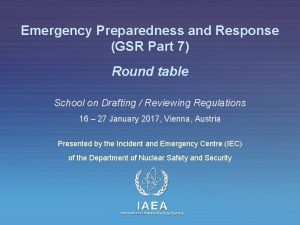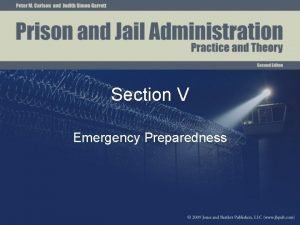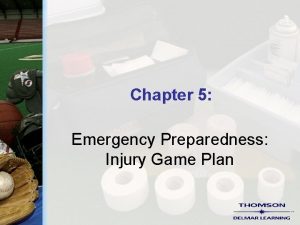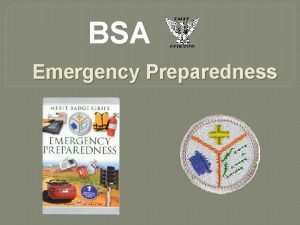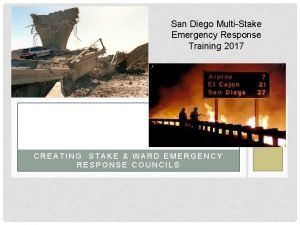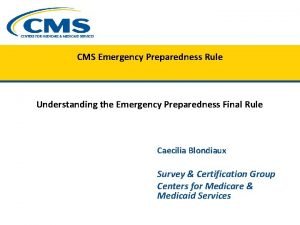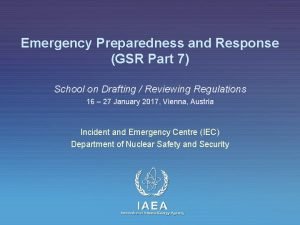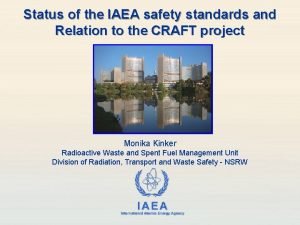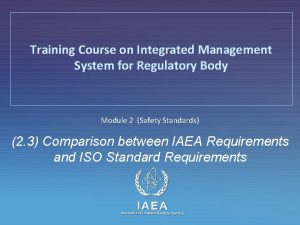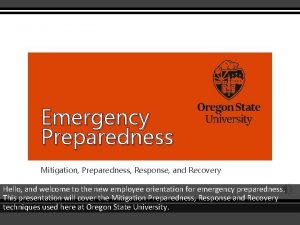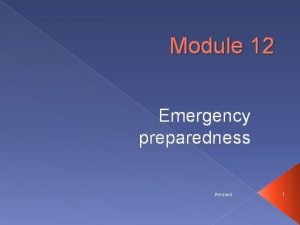Emergency Preparedness and Response GSR Part 7 Round











- Slides: 11

Emergency Preparedness and Response (GSR Part 7) Round table School on Drafting / Reviewing Regulations 16 – 27 January 2017, Vienna, Austria Presented by the Incident and Emergency Centre (IEC) of the Department of Nuclear Safety and Security IAEA International Atomic Energy Agency

Introduction • Requirement 4: The government shall ensure that a hazard assessment is performed to provide a basis for a graded approach in preparedness and response for a nuclear or radiological emergency. • An essential issue of the hazard assessment process is drawing up and selecting the accidents scenarios likely to occur in your country • A hazard assessment will determine the degree of planning required…one must know the risk IAEA

Hazard assessment • Concept remained unchanged from threat assessment with few updates: ü Emphasis given to types of events to be considered in hazard assessment, e. g. : • Events of low probability, events coincident with conventional emergency and events affecting multiple facilities and activities ü Emergency preparedness categories • Categories I, II and III unchanged • Categories IV and V redefined for clarity IAEA

Criteria for Determining Emergency Preparedness (EP) Categories EP Category Radiological hazard I Severe deterministic health effects off-site II Warranting urgent protective actions off-site, deterministic health effects on-site III No urgent protective actions off-site are warranted, severe deterministic health effects on-site IV Activities and acts with the potential to trigger a radiation emergency that could warrant protective actions and other response actions in an unforeseen location. V Areas within emergency planning zones and distances for a facility in category I or II not located in the State where the facility is located IAEA

Category I • Category I: severe deterministic health effects off site • Reactors with power levels greater than 100 MW(th) (power, nuclear ship and research reactors) • Spent fuel pools that may contain some recently discharged fuel • Facilities with inventories of dispersible radioactive material sufficient to result in severe deterministic effects offsite IAEA

Category II • Category II: doses warranting taking urgent • • protective action off site Reactors with power levels greater than 2 MW(th) and less than 100 MW(th) Spent fuel pools containing fuel requiring active cooling Facilities with potential for an uncontrolled criticality within 0. 5 km of the off-site boundary Facilities with inventories of dispersible radioactive sufficient to result in doses warranting taking urgent protective action off site IAEA

Category III • Category III: doses warranting taking urgent protective action on site • Facilities with potential, if shielding is lost, of direct external (shine) dose rates of more than 100 m. Gy/h at 1 m • Reactors with power levels of less than or equal to 2 MW(th) • Facilities with inventories of radioactive sufficient to result in doses warranting taking urgent protective action on the site IAEA

Category IV • Category IV: doses warranting taking urgent • • protective action in an unforeseen location Operators of mobile dangerous sources with potential, if shielding is lost, of direct external (shine) dose rates of more than 10 m. Gy/h at 1 m Satellites with dangerous sources Transport of quantities of radioactive material that would be dangerous if not controlled Facilities/locations with a significant probability of encountering an uncontrolled dangerous source (e. g. large scrap metal processing facilities, national border crossings, airports and seaports etc. ) IAEA

Category V • Category V: areas within emergency planning zones and distances in a State for a facility in: • Category I or • Category II located in another State Image courtesy IAEA

Sizes of Emergency Zones and Distances Emergency zones and distances Suggested radius (km) ≥ 1000 MW(th) PAZ: Precautionary action 3 to 5 zone UPZ: Urgent protective action 15 to 30 planning zone EPD: Extended planning distance ICPD: Ingestion and commodities planning distance IAEA ≥ 100 to 1000 MW(th) 100 50 300 100

Discussion • With the knowledge that you have so far, what kind of emergency preparedness categories can you identify in your country? IAEA
 Gsr part 7
Gsr part 7 Chapter 36 emergency preparedness and protective practices
Chapter 36 emergency preparedness and protective practices Chapter 36 emergency preparedness and protective practices
Chapter 36 emergency preparedness and protective practices Chapter 5 emergency preparedness injury game plan
Chapter 5 emergency preparedness injury game plan Bsa emergency preparedness
Bsa emergency preparedness National radiological emergency preparedness conference
National radiological emergency preparedness conference Stake emergency preparedness plan
Stake emergency preparedness plan Cms emergency preparedness rule
Cms emergency preparedness rule Gsr part7
Gsr part7 Part5ds
Part5ds Gsr part 1
Gsr part 1 Integrated management systems training north america
Integrated management systems training north america
